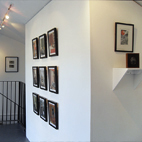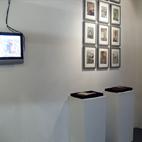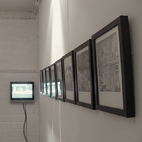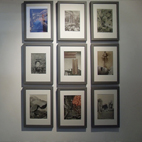
Robert Holcombe: Folklore, Ritual and the Modern Interior (1955 – 1975)
Exhibition open:
15.2.14 – 9.3.14
Sat. – Sun. 12:00 – 18:00
Private view:
Thursday February 13th 19:00 – 21:00
“I am fascinated by self-erasure. The more stridently our world demands that we prize individual uniqueness and choice above the connections between us, the more obvious it becomes that we choose one poor print from a very limited range. Still, paradox is our friend. We resist the effort to shape us by a refusal to accept the stifling conformity of being ourselves…” [RH: Unpublished Letter to Eduardo Paolozzi (1984)]
“I’m interested in all the strange stuff that circulates in our heads now: histories where fact bleeds into fiction, advertising and propaganda, stories that pretend they’re showing the world as it is, or could be, if we’d just work harder and do as we’re told. To be effective, that kind of material needs to tap into something truthful about what we do really want, subconsciously, but I’m not sure anyone can predict exactly how releasing those authentic desires along with the fabricated ones will play out. What if we buy into the desires they’re fabricating for us more deeply than they imagine possible – and then act on them?” [RH: Unpublished Letter To Eduardo Paolozzi (1972)]
Robert Holcombe is an entirely fictional British artist (b. Leeds 1923 - d. Exeter 2003) whose fascination with collage was first discovered when he began cutting up magazines and rearranging the parts whilst convalescing from injuries sustained in 1944, during active service in Malaya. He was a radio engineer, a contemporary of Richard Hamilton at the Slade School of Art between 1948 and 1951 and, from 1955 until 1988, a planning officer in the city of Leeds. His early, if oblique, involvement with the Independent Group continued into the 1980s, and he maintained a long correspondence with Eduardo Paolozzi, whose interest in elaborate fictions and alternate realities he shared.
Although Holcombe did not exhibit publicly during his lifetime, he made most of his work under two pseudonyms – Gene and Michael Harrison. It’s also notable that many of his images, particularly those featuring material rooted in fashion, advertising and technology, show a more ambiguous enthusiasm for the world of the Post-War era than was generally usual at the time. The consumerist excesses of the Immersions series (1970 – 71), the inscrutable apparitions of surgical, sexual and folkloric symbols inside modernist interiors elsewhere, alongside the many disturbances of ordinary spaces that colour the whole body of work, all suggest an artist with a satirical as well as unsettling and surreal take on the emerging society and politics of his age.
For more information on Robert Holcombe: http://wayneburrows.wordpress.com/
Read a review of the exhibition here.
 [1969].jpg)



